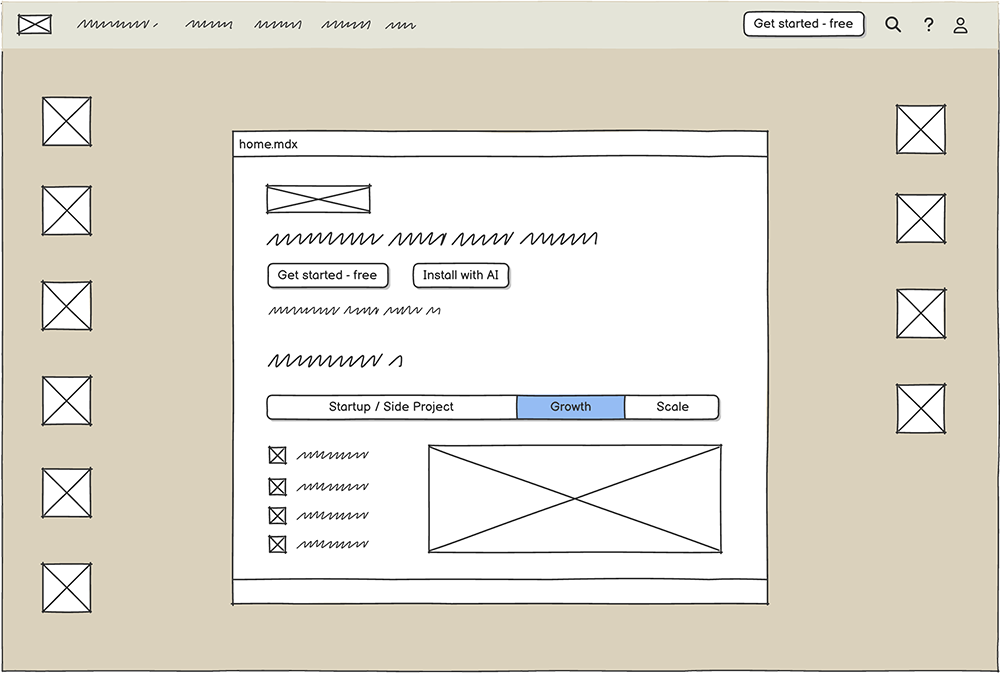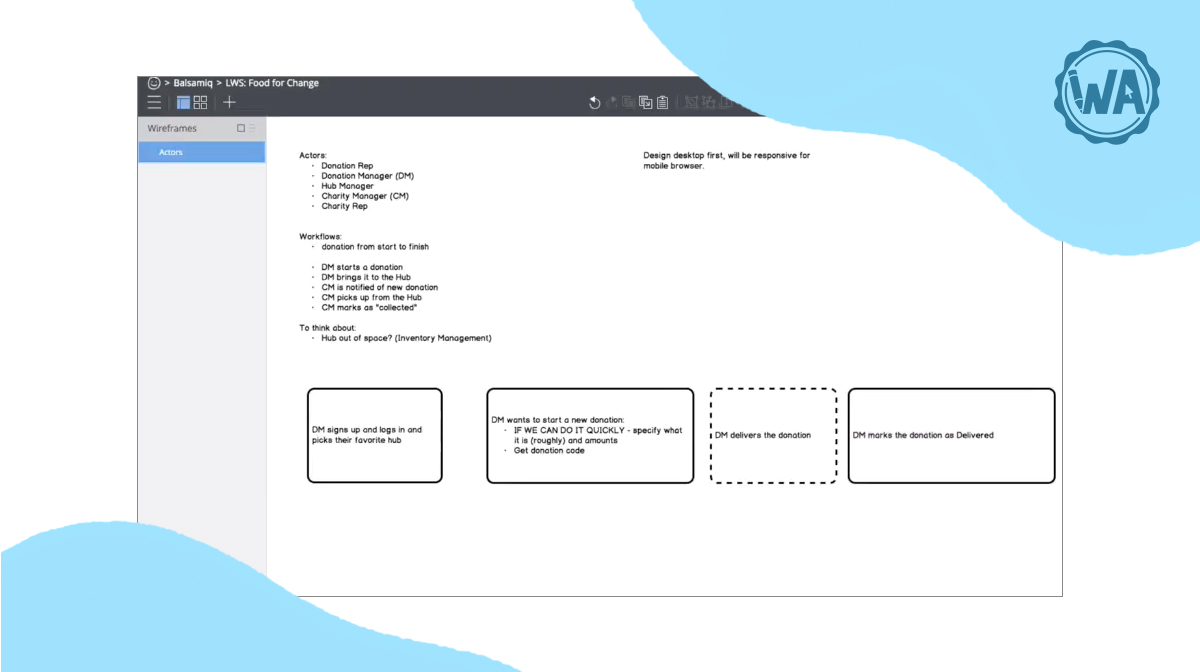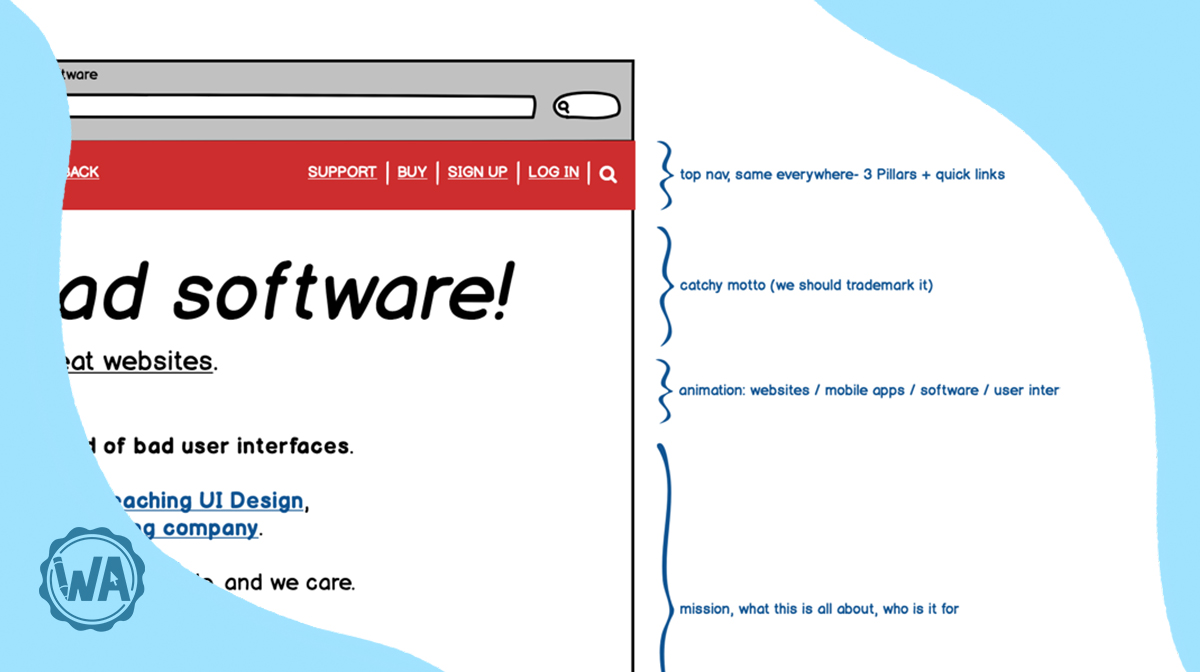Ok, so you’ve built your wireframes—great! You’re done, right? Well… not so fast.
Now comes the moment all your brainstorming and dragging-and-dropping have been leading up to: presenting your wireframe.
And, contrary to popular belief, this step isn’t just about walking people through a few screens or showcasing what you built.
It’s about something much bigger—creating alignment, making decisions, and getting everyone, from project managers to developers, on the same page about what you’re building and why.
Because here’s the thing: a wireframe isn’t a final product, it’s a thinking tool—a visual document meant to spark feedback, discussion, and decision-making.
That’s where this guide comes in. We’ll give you wireframe presentation tips so you can properly:
- Frame the discussion
- Collect feedback from key stakeholders
- Turn your wireframe from “here’s a sketch” into “here’s our next step forward.”
Let’s dive in!
1. Start with the why: Set the stage before showing the screen
Before you jump into the “show” part of your wireframe show-and-tell, take a moment to set the stage. A successful presentation starts with clarity, not just visuals.
Ask yourself:
- What problem is this wireframe project trying to solve?
- Why am I showing this now?
- What kind of input am I looking for—approval, direction, gut checks?
Once you have those answers, turn them into a short narrative to kick off your presentation. For example:
“We’ve been hearing from users that onboarding feels clunky. This wireframe project is our first pass at simplifying that flow. We’re looking for feedback on whether this direction makes sense—and if we’re reducing the time from sign-up to aha moment.”
This kind of framing shifts the mood of the meeting from judgment to collaboration. Suddenly, it’s not, “Let me pick apart this design,” but “Let’s solve this together.”
As you present, remember to be honest about your decisions. Call out trade-offs and explain your reasoning. People engage more deeply when they understand the why behind what they see.
Think of (and present) your wireframe like a pitch deck for a solution, not just a sketch of it, and you’ll be amazed at how productive your conversations get.
2. Build the story: Recap, bridge, and show what’s next
One of the fastest ways to derail a wireframe presentation is to drop a screen into the room without context.
When that happens, everyone zooms into small details, i.e., “Should this button be on the left or right?”, rather than focusing on the bigger picture.
That’s why a key part of how to present wireframes effectively is giving the room the right context before diving into the design itself.
- Recap: What came before these wireframes? Think past research, user pain points, last sprint outcomes—essentially, whatever spurred your wireframes into existence.
- Bridge: What’s this version trying to achieve? For example, shortening an existing flow to prevent users from dropping off, or clarifying user options to avoid overloading the support team.
- Forward: What comes next if this gets approved? Maybe it leads to running usability testing next week, or becomes the foundation for a feature in your next major release. Giving a glimpse of what’s ahead helps stakeholders see this version as progress, not just a mockup.
By giving context, you’ll turn your wireframe into a chapter of a story—one with a clear beginning, middle, and end. When people understand where they are in the story, they’re less likely to get stuck on small details and more likely to contribute meaningfully.
3. Invite collaboration, not just approval
You’ve put in the work, crafted a solid set of wireframes, and now it’s finally time to show them off. The last thing you want is a bunch of critiques, right?
Actually, that’s precisely what you should want. Seriously.
Remember that feedback is the goal. After all, a wireframe isn’t a finished product; it’s a working idea made visible. And presenting it shouldn’t feel like defending a masterpiece, but rather like opening a conversation.
Great products come from collaboration. That means making space for input—even if some of it stings a little. So, rather than getting defensive, lean into co-creation by:
- Flagging areas you’re unsure about. Whether it’s your first wireframe or your 20th, you likely won’t have all the answers, so don’t pretend to. Plus, you might be presenting to subject matter experts who have the exact insights you’ve been missing, so use that to your advantage.
- Bringing a couple of options. If you suspect something might spark debate, come prepared with 1–2 alternate approaches. It shows thoughtfulness and flexibility, and invites others into your design process.
- Making it interactive. Want real engagement? Don’t just talk about the wireframe—work on it together. Open your wireframing tool (like Balsamiq) and tweak ideas live. This will turn passive viewers into active collaborators and help validate stakeholder feedback on wireframes in real time.
This short video from Nielsen Norman Group reinforces these ideas.
And finally, be ready to explain your design choices. Again, the goal isn’t to get unanimous approval—it’s to help stakeholders understand the reasoning behind your work.
You don’t need to prepare a full-blown lecture, but you should be able to clearly explain your choices. For example:
- “This layout follows a common design pattern users already recognize.”
- “We chose this flow because it supports the primary use case that we identified in user research.”
- “This constraint is based on existing platform limitations.”
- “We simplified this interaction to reduce support tickets from confused users.”
A strong design isn’t enough on its own. Without a clear explanation of your process and rationale, your wireframes can easily be misunderstood or dismissed. And when stakeholders understand the “why,” they’re far more likely to get on board with (and help shape) the “what.”
Remember, inviting others into your design process doesn’t mean losing control; it means building shared ownership. And when people feel ownership, they don’t just give better feedback—they become your allies.
Giulio Michelon explains why you can't (and shouldn't) expect to nail your wireframe on the first try
When I caught up with Giulio Michelon, Founder of Belka, we talked about his approach to sharing wireframes with key stakeholders. He shared:
"Designers and product managers often dream of nailing it on the first try—presenting a solution so perfect that everyone gasps and says, "That's exactly what we need!" Their moms are proud, the day is saved, and all is right with the world.
Every comment on your wireframes isn't criticism. It's insight from your teammates that you didn't have. The job of a designer isn't to always be right. It's to collect those small bits of feedback (and sometimes the big ones) and weave them into a better product. That's why I actually love getting pushback on my work. It means the team is engaged and making the design stronger."
4. Use the wireframes as an interactive whiteboard
Interaction is once again the name of the game. Rather than running a traditional (and usually a bit boring) static slide deck, use your wireframes as a dynamic whiteboard for the meeting.
Annotate your wireframe live. Circle things. Point out flows. Let the design become part of the conversation, not just something people watch passively.
Skip the generic, “Do you like it?”, and opt for actionable questions like:
- “Does this feel like it solves the core problem?”
- “Are we making any assumptions here that we should revisit?”
- “Does this feel intuitive based on the user’s goals?”
This approach keeps the discussion focused, concrete, and productive. It turns your presentation from a one-way pitch into a two-way workshop.
And, as a bonus, people are far more likely to remember and engage with a design they’ve interacted with directly.
5. Speak in your stakeholders’ language to translate your pitch into action
When presenting UI wireframes, keep in mind that not everyone will interpret them the same way you do.
Different stakeholders bring different perspectives, and one of the most valuable skills you can develop is knowing how to explain wireframes to stakeholders in a way that speaks to their specific concerns and priorities.
Here’s how various team members typically approach a wireframe—and how to meet them where they are:
Product Managers want to know: “Does this solve the right problem? Are we on track with scope, goals, and strategy?”
- You’ll need to explain how the flow aligns with user needs or OKRs, and what trade-offs you made to keep things simple and faster to build.
Developers are asking: “Can we build this efficiently? Are there any technical blockers?”
- Point out areas that reuse elements the dev team has already built and call attention to any parts that might require custom work.
Executives are thinking: “Will this drive results? How fast can we get this in front of users?”
- Focus on outcomes. Tie the design to metrics like retention, engagement, or revenue. Explain how this version is faster, clearer, or more aligned with current goals.
This isn’t solely about being persuasive—it’s about being relevant. Make sure your wireframes speak to everyone in the room, so they can give useful feedback and make informed decisions.
Think like a facilitator, not just a presenter
Wireframes aren’t just rough drafts of design—they’re decision-making tools. That’s why learning how to present wireframes isn’t about showing off visuals; it’s about guiding a conversation.
You’re not just a presenter but a facilitator, helping the team align, respond, and move forward.
Let’s recap the playbook:
- Frame the conversation by explaining the “why” before showing the “what”
- Give context so people understand how this wireframe fits into the bigger picture
- Collaborate, don’t defend—invite input and show your thinking
- Let the wireframes lead the discussion, not just sit on display
- Speak stakeholder—tailor your message to who’s in the room
By doing this, your wireframes stop being sketches on a screen and start becoming a catalyst for real momentum.
Ready to turn your next idea into a clear, collaborative wireframe—faster? Our rapid wireframing course shows you how.











